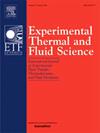冲击高速旋转表面的液滴扩散与飞溅特性研究
IF 3.3
2区 工程技术
Q2 ENGINEERING, MECHANICAL
Experimental Thermal and Fluid Science
Pub Date : 2025-08-11
DOI:10.1016/j.expthermflusci.2025.111591
引用次数: 0
摘要
在航空发动机领域,液滴冲击压气机叶片是一种常见的现象,具有重要的研究意义。在预压气机冷却质量喷射过程中,大量液滴被喷射到进气管道中。未蒸发的液滴不可避免地与压气机叶片发生碰撞,影响其性能,影响湿压缩过程。因此,研究液滴对旋转表面的影响是十分必要的。实验研究了液滴在旋转表面上的撞击过程,考虑了撞击速度、转速和撞击位置半径的影响。重点研究了高转速工况。主要观察结果包括不对称扩散、飞溅和二次液滴的产生。结果表明,不同的转速会导致液滴撞击后的不同结果。在较低的转速下,液滴沉积在表面并进行不对称扩散。相反,在更高的转速下,液滴飞溅和破裂,产生二次液滴。经统计分析,撞击旋转表面产生的二次液滴平均直径在初始液滴直径的0.08 ~ 0.25倍之间。提出了二次液滴直径分布参数与平均粒径的关系。本文章由计算机程序翻译,如有差异,请以英文原文为准。
Study on the spreading and splashing characteristics of droplets impacting a high-speed rotating surface
In the field of aero engines, droplet impact on compressor blades is a common phenomenon that holds significant importance for research. During the mass injection of pre-compressor cooling, a large number of droplets are injected into the intake duct. The droplets that do not evaporate inevitably collide with the compressor blades, affecting their performance and influencing the wet compression process. Therefore, it is essential to study the impact of droplets on rotating surfaces. This paper experimentally investigated the droplet impact process on a rotating surface, considering the effects of impact velocity, rotational speed, and the radius of the impact location. The condition with high rotational speed was investigated especially. Key observations included asymmetric spreading, splashing, and the generation of secondary droplets. The results indicated that varying rotational speeds led to different outcomes following droplet impact. At lower rotational speeds, droplets deposited on the surface and undergo asymmetric spreading. In contrast, at higher rotational speeds, droplets splashed and broke up, producing secondary droplets. Through statistical analysis, the average diameter of the secondary droplets generated by impact on the rotating surface was in the range between 0.08 and 0.25 times the diameter of initial droplet. The correlations for the diameter distribution parameters and the average diameter of the secondary droplets have been proposed.
求助全文
通过发布文献求助,成功后即可免费获取论文全文。
去求助
来源期刊

Experimental Thermal and Fluid Science
工程技术-工程:机械
CiteScore
6.70
自引率
3.10%
发文量
159
审稿时长
34 days
期刊介绍:
Experimental Thermal and Fluid Science provides a forum for research emphasizing experimental work that enhances fundamental understanding of heat transfer, thermodynamics, and fluid mechanics. In addition to the principal areas of research, the journal covers research results in related fields, including combined heat and mass transfer, flows with phase transition, micro- and nano-scale systems, multiphase flow, combustion, radiative transfer, porous media, cryogenics, turbulence, and novel experimental techniques.
 求助内容:
求助内容: 应助结果提醒方式:
应助结果提醒方式:


